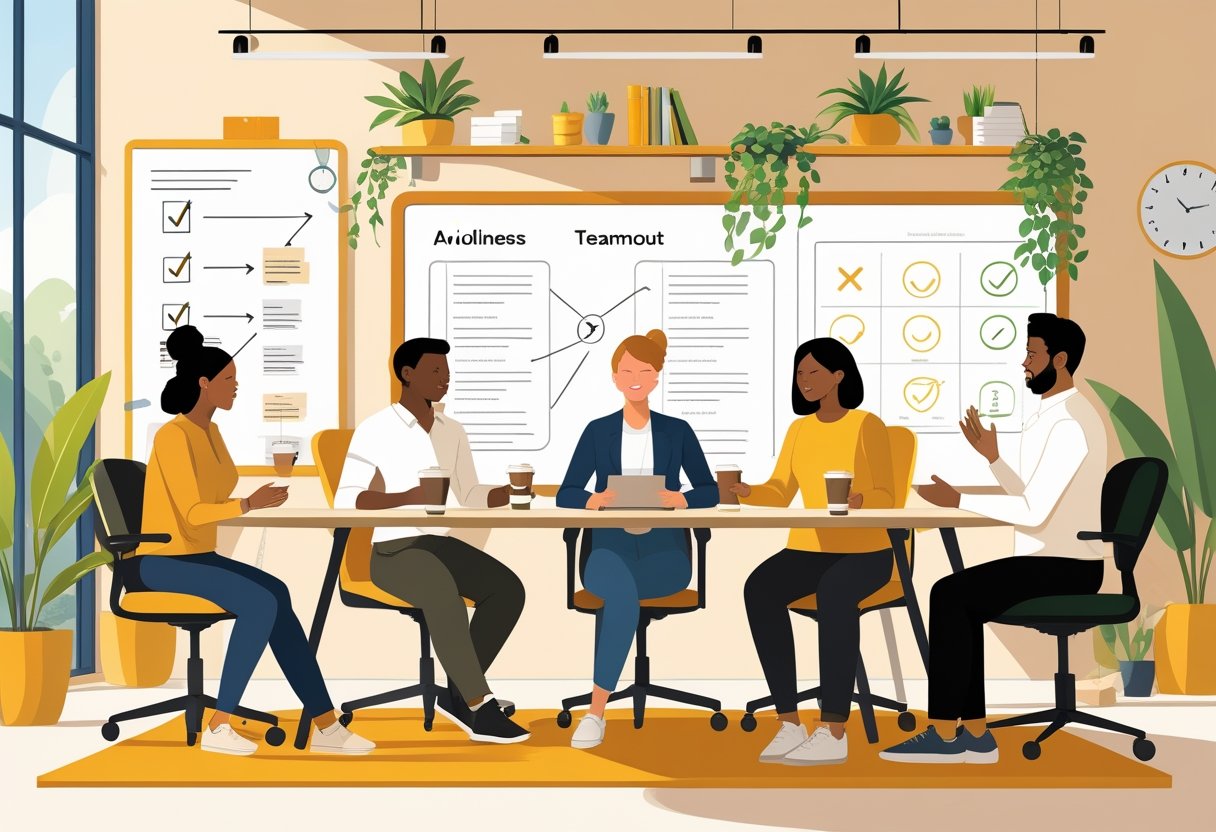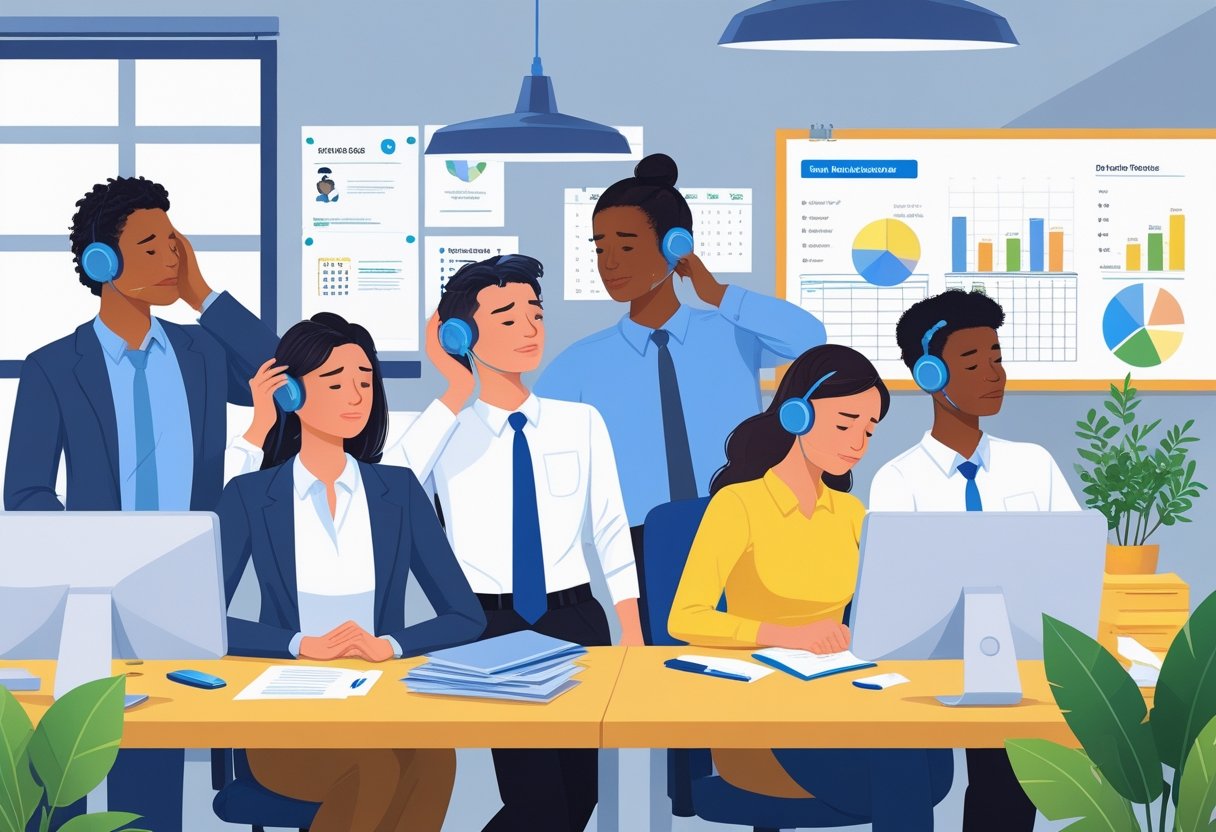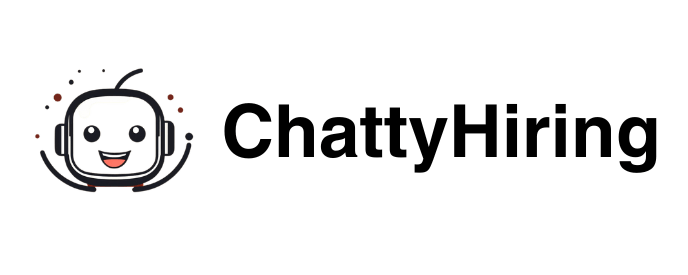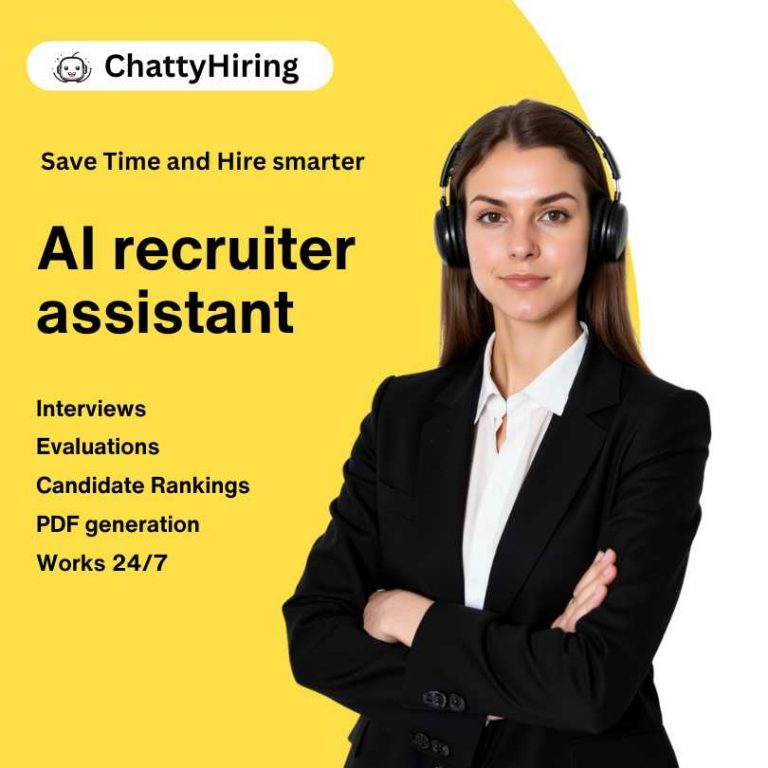Recruitment teams face unique pressures that make them especially vulnerable to burnout. The constant demand to fill positions quickly, manage multiple clients, and navigate competitive job markets creates a perfect storm for stress and exhaustion.
Research shows that over 80% of workers experienced burnout last year, with recruitment professionals particularly at risk due to the high-pressure nature of their work.

The key to preventing recruitment team burnout is to use proactive strategies that address workload management, team well-being, and professional development before any warning signs show up.
Leaders who spot early symptoms and take quick action can keep productivity high while protecting their team’s mental health and job satisfaction.
Understanding how to spot burnout indicators, streamline recruitment processes, and build supportive work environments will help managers create resilient teams.
This approach keeps recruiters engaged and effective while maintaining the work-life balance needed for long-term success in this demanding field.
Recognizing Burnout in Recruitment Teams

Burnout shows up through clear warning signs that hit both individual recruiters and the team’s performance. If left unchecked, it impacts talent acquisition quality, candidate relationships, and overall organizational success.
Common Signs and Causes of Recruiter Burnout
Mental fatigue is usually the first sign of recruiter burnout. Recruiters may struggle to focus during interviews and make more mistakes in candidate evaluations.
Physical symptoms can include chronic tiredness and frequent headaches. Some recruiters might start arriving late or calling in sick more often.
Emotional exhaustion shows up as increased irritability with candidates and colleagues. Burned-out recruiters feel overwhelmed, cynical, and disconnected from their work.
Primary causes include:
- Unrealistic hiring targets and tight deadlines
- High-pressure work environments with constant multitasking
- Lack of proper recruitment tools and automation
- Frequent candidate rejections and dropouts
- Poor work-life balance policies
Unmanageable workloads and unrealistic targets overwhelm recruiters, leading to stress and exhaustion. HR teams sometimes set goals that aren’t realistic for any recruiter.
Repetitive tasks without variety can drain motivation over time. Doing the same screening calls and admin work daily makes it tough to stay engaged.
Impact on Talent Acquisition and Team Performance
Burnout takes a toll on the quality of talent acquisition efforts. Exhausted recruiters rush through candidate screenings and miss key qualifications.
Team productivity drops as burned-out members make fewer placements each month. They spend more time on each task because their focus and energy are down.
Performance indicators affected:
- Lower placement rates and longer time-to-fill
- More errors in candidate assessments
- Missed client deadlines and slow communication
- Less collaboration between team members
Knowledge transfer suffers when experienced recruiters leave often. New hires need months of onboarding before they’re fully up to speed.
Client relationships can go downhill due to inconsistent service. Burned-out recruiters may struggle to show enthusiasm during client calls or meetings.
How Burnout Affects Candidate Experience
Candidates can tell right away when recruiters lack energy or enthusiasm during interviews. This leaves a bad first impression of both the recruiter and the client company.
Communication quality drops as burned-out recruiters delay responses to candidate questions. Important follow-ups and updates might get pushed aside or missed completely.
Exhausted, demotivated recruiters struggle to engage candidates effectively. They might give less detailed job info or skip over what makes a company unique.
Screening can become superficial when recruiters are mentally drained. They may ask fewer behavioral questions and spend less time checking for cultural fit.
The recruitment process can start to feel impersonal and transactional. Candidates may get generic feedback instead of real insights about their interviews.
Negative candidate experiences include:
- Delayed communication and missed calls
- Rushed interviews with little time for questions
- No personalized career advice or market insights
- Poor prep for client interviews and feedback sessions
Top candidates will often choose to work with other agencies that offer better service. This can hurt your agency’s reputation in a competitive talent market.
Optimizing Workflows and Processes

Recruitment teams can avoid burnout by streamlining operations and cutting out redundant steps. Using automated tools to handle repetitive tasks is a game-changer.
Clear communication with hiring managers and structured processes help reduce stress and make hiring workflows more efficient.
Streamlining the Recruitment Process
Recruitment often has unnecessary steps that slow things down and frustrate the team. Mapping out your current workflow is a good way to spot bottlenecks and repetitive tasks.
Common process inefficiencies include:
- Multiple approval layers for job postings
- Duplicate candidate screening steps
- Too many interview rounds
- Manual data entry across systems
Standardized templates for job descriptions and interview questions save a ton of time. You don’t have to reinvent the wheel for every new role.
Setting clear timelines for each hiring stage helps keep things moving. If hiring managers know they have 48 hours to review candidates, decisions get made faster.
Streamlined workflow benefits:
- Faster time-to-hire
- Less recruiter workload
- Better candidate experience
- Lower stress
Teams should regularly review their process and cut steps that don’t add value. Even small tweaks can make a big difference in daily stress levels.
Leveraging Recruiting Tools and Automation
Automating routine admin tasks like scheduling interviews or sending follow-ups lets recruiters focus on building relationships.
Applicant tracking systems (ATS) can screen resumes for keywords and qualifications automatically. This saves hours of manual review for each role.
Key automation opportunities:
- Interview scheduling and reminders
- Candidate status updates
- Reference check coordination
- Offer letter generation
Calendar integration tools let candidates self-schedule interviews. This cuts out the back-and-forth and speeds up the process.
Automated email sequences keep candidates in the loop about their application status. That means less manual work for recruiters and a better candidate experience.
Pick tools that integrate with what you already use. Too many disconnected platforms can actually make things harder, not easier.
Enhancing Collaboration with Hiring Managers
Poor communication with hiring managers adds extra work and delays for recruiters. Setting clear expectations and structured processes can make this relationship a lot smoother.
Regular intake meetings help recruiters really understand the requirements before posting a job. This means fewer misaligned candidate submissions and less rework.
Effective collaboration includes:
- Detailed job requirement discussions
- Agreed-upon candidate evaluation criteria
- Set timelines for feedback and decisions
- Regular status update meetings
Hiring managers should get some basic training on interviewing and legal compliance. This saves recruiters from having to fix problems later.
Feedback templates help hiring managers give specific, useful input on candidates. Vague feedback like “not a good fit” just leaves recruiters guessing.
Shared dashboards give hiring managers real-time updates on open positions. This means fewer status requests and emails for recruiters to handle.
Improving Workflow to Reduce High Turnover
High turnover in recruitment teams often comes from inefficient processes that cause constant stress and overtime. Spotting workflow bottlenecks can help fix the root issues.
Unrealistic hiring timelines force recruiters to cut corners or work long hours. Teams should set expectations based on the market and how tough the role is to fill.
Workflow improvements that reduce turnover:
- Balanced recruiter workloads
- Clear priority systems for urgent roles
- Regular process improvement meetings
- Cross-training to avoid single points of failure
A poor candidate experience reflects badly on recruiters and creates extra work when dealing with complaints. Streamlined processes lead to better interactions and less negative feedback.
Track metrics like time-to-hire and candidate satisfaction scores. These numbers show where your process needs work.
Regular team feedback sessions help spot workflow problems before they lead to burnout. Recruiters know best which daily tasks are the most frustrating.
Promoting Well-Being and Engagement
Building a sustainable work environment means addressing the unique stressors recruiters face. It’s all about setting clear boundaries between work and personal time, building authentic employer brands, and tackling mental exhaustion head-on.
Supporting Work-Life Balance for Recruiters
Recruiters are always under pressure to fill roles fast. This often leads to long hours and weekend calls with candidates.
Leaders should set clear boundaries around communication hours. Checking in regularly with team members helps spot workload issues and set realistic expectations.
Flexible scheduling options help recruiters manage their energy:
- Let recruiters block time for focused work between calls
- Allow schedule changes during peak hiring seasons
- Offer remote work for phone screening days
- Set up quiet zones for resume reviews
Recruiters need some control over their daily schedules. Micromanaging every call or requiring constant updates just adds more stress.
Focus on results, not processes. Trust your recruiters to manage their pipelines, but be there to support them when needed.
Fostering a Healthy Employer Brand
A strong employer brand makes recruitment easier and less stressful. If your company has a bad reputation, attracting quality candidates gets tough.
Key elements of recruiter-friendly employer brands include:
| Element | Impact on Recruiters |
|---|---|
| Competitive compensation | Easier candidate attraction |
| Growth opportunities | Reduces rejection rates |
| Positive reviews online | Fewer defensive conversations |
| Clear company values | Simplified candidate screening |
Organizations that foster a positive atmosphere see better recruitment outcomes. This takes pressure off recruiters to oversell roles.
Marketing and recruiting teams should work together to create authentic content. Real employee stories and straightforward job descriptions set honest expectations.
Social media presence matters a lot. Candidates check companies out online before applying, and a negative image makes recruiters’ jobs much harder.
Addressing Mental Fatigue and HR Burnout
Recruitment is full of rejection and emotional labor. Recruiters hear “no” a lot and still have to stay upbeat in tough conversations.
Mental fatigue builds up from repetitive tasks. Screening tons of resumes or running back-to-back interviews can drain anyone.
Strategies for combating mental exhaustion:
- Rotate recruiters between different role types
- Offer training on emotional resilience
- Schedule regular breaks between candidate calls
- Give access to mental health resources
Recognition is key to preventing burnout. Be specific—tell recruiters exactly how their work impacts the business.
Instead of just saying “good job,” explain how a placement solved a real business challenge.
Anonymous feedback systems for reporting burnout let team members ask for help without feeling judged. Many recruiters won’t admit they’re struggling in a competitive environment.
Peer support networks within recruitment teams can make a big difference. Experienced recruiters can mentor newer team members through tough times.
Investing in Professional Development and Team Support
Strong recruitment teams need ongoing investment in their skills and well-being to avoid burnout.
Professional development gives recruiters opportunities to learn new skills and grow professionally. Structured support systems help retain top talent.
Offering Professional Development Opportunities
Professional development is an excellent way to prevent recruiter burnout. When talent acquisition teams pick up new skills, they become more confident and engaged.
Excellent development programs include training on the latest recruitment technologies and platforms. Teams gain from learning advanced sourcing strategies and interview frameworks.
Social media recruiting and employer branding workshops keep recruiters up-to-date with industry trends.
Key Development Areas:
- Advanced Boolean search techniques
- Candidate experience optimization
- Diversity and inclusion recruiting
- Data analytics and metrics tracking
- Communication and negotiation skills
Regular skills assessments help pinpoint knowledge gaps. Managers can build individualized development plans tailored to each recruiter’s career path and current skill set.
External conferences and industry events give recruiters valuable networking opportunities. Online certifications from professional recruiting organizations offer flexible learning options that fit busy schedules.
Implementing Onboarding and Mentorship Programs
Strong onboarding programs lower stress for new recruiters. Thorough training helps them understand company processes and expectations right from the start.
Structured mentorship matches seasoned recruiters with new hires. This setup provides support and guidance beyond initial onboarding.
Effective Onboarding Components:
- 30-60-90 day check-ins
- Clear role expectations and metrics
- Shadow experienced recruiters on calls
- Gradual increase in recruiting responsibilities
- Regular feedback sessions
Mentors assist new recruiters with challenging situations and tough candidates. They offer practical advice that goes beyond what’s found in training materials.
HR teams should track mentorship pairings to ensure they’re effective. Ongoing feedback helps refine the program.
Cross-training gives recruiters exposure to different talent segments and industries. This variety keeps things interesting and builds a more adaptable team.
Retaining Talent Through Ongoing Support
Ongoing support systems help prevent experienced recruiters from leaving due to burnout.
Regular career conversations show team members that leadership values their growth.
Clear advancement paths motivate recruiters to stay engaged.
Teams need to see opportunities for promotion within the organization rather than seeking external opportunities.
Retention Strategies:
Performance feedback should focus on growth rather than criticism.
Constructive conversations help recruiters improve without feeling overwhelmed or inadequate.
HR teams must track retention metrics to measure program effectiveness.
Exit interviews with departing recruiters provide valuable insights for improving support systems.
Budget allocation for professional development demonstrates organizational commitment to employee growth.
This investment typically pays for itself through reduced turnover costs.
-

A passionate advocate for the future of HR innovation. With expertise in leveraging AI to revolutionize recruitment processes, Carlos has a clear vision: empower HR teams while creating meaningful candidate experiences.
View all posts





